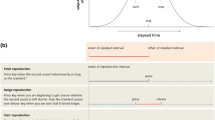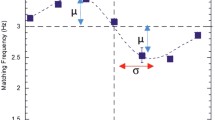Abstract
The ability to estimate a filled interval of time is affected by numerous non-temporal factors, such as the sensory modality, duration, and the intensity of the stimulus. Here we explore the role of modality (auditory or visual), stimulus intensity (low vs. high), and motor response speed on the ability to reproduce the duration of short (<1 s) filled intervals. In accordance with the literature, the reproduced duration was affected by both the modality and the intensity of the stimulus; longer reproduction times were generally observed for visual as compared to auditory stimuli, and for low as compared to high-intensity stimuli. We used general estimating equations in order to determine whether these factors independently affected participants’ ability to reproduce a given duration, after eliminating the variability associated with reaction time, since it covaried with the reproduced durations. This analysis revealed that stimulus duration, modality, and intensity were all significant independent predictors of the reproduced durations. Additionally, duration interacted with intensity when reproducing auditory intervals. That is, after taking into account the general speeding-up effect that high-intensity stimuli have on responses, they seem to have an additional effect on the rate of the internal clock. These results support previous evidence suggesting that auditory and visual clocks run at different speeds.




Similar content being viewed by others
Notes
To minimize any learning effects, for one-seventh of the trials, the sample duration was random (500–1100 ms); the trials containing random durations were not analysed since there were usually no repetitions.
References
Allan LG (1979) The perception of time. Percept Psychophys 26:340–354
Allan LG (1992) The internal clock revisited. In: Macar F, Pouthas V, Freidman W (eds) Time, action and cognition: towards bridging the gap. Kluwer Academic, London, pp 191–202
Allan LG (1998) The influence of the scalar timing model on human timing research. Behav Process 44:101–117
Angel A (1973) Input-output relations in simple reaction time experiments. Q J Exp Psychol 25:193–200
Belin P, McAdams S, Thivard L, Smith B, Savel S, Zilbovicius M, Samson S, Samson Y (2002) The neuroanatomical substrate of sound duration discrimination. Neuropsychologia 40:1956–1964
Berglund B, Berglund U, Ekman G, Frankenhaeuser M (1969) The influence of auditory stimulus intensity on apparent duration. Scand J Psychol 10:21–26
Brown DR, Hitchcock L (1965) Time estimation: dependence and independence of modality-specific effect. Percept Mot Skills 21:727–734
Cappelletti M, Freeman ED, Cipolotti L (2009) Dissociations and interactions between time, numerosity and space processing. Neuropsychologia 47:2732–2748
Dormal V, Pesenti M (2007) Numerosity-length interference: a Stroop experiment. Exp Psychol 54:289–297
Droit-Volet S (2010) Stop using time reproduction tasks in a comparative perspective without further analyses of the role of the motor response on the temporal performance. The case of children. Eur J Cogn Psychol 22:130–148
Eagleman DM, Pariyadath V (2009) Is subjective duration a signature of coding efficiency? Philos Trans R Soc B 364:1841–1851
Fraisse P (1964) The psychology of time. Eyre & Spottiswoode, London
Fraisse P (1984) Perception and estimation of time. Annu Rev Psychol 35:1–36
Gibbon J, Church RM, Meck WH (1984) Scalar timing in memory. In: Gibbon J, Allan L (eds) Annals of the New York Academy of Sciences, 423: Timing and time perception. New York Academy of Sciences, New York, pp 52–77
Gil S, Droit-Volet S (2011) Time flies in the presence of angry faces…depending on the temporal task used. Acta Psychol 136:354–362
Goldstone S (1968) Production and reproduction of duration: intersensory comparisons. Percept Motor Skills 26:755–760
Goldstone S, Goldfarb JL (1964) Auditory and visual time judgment. J Gen Psychol 70:369–387
Goldstone S, Lhamon WT (1974) Studies of auditory-visual differences in human time judgment: 1. Sounds are judged longer than lights. Percept Motor Skills 39:63–82
Goldstone S, Lhamon WT, Sechzer J (1978) Light intensity and judged duration. Bull Psychon Soc 12:83–84
Hirsh IJ, Bilger RC, Deatherage BH (1956) The effect of auditory and visual background on apparent duration. Am J Psychol 69:561–574
Jaśkowski P, Jaroszyk F, Hojan-lezierska D (1990) Temporal-order judgments and reaction time for stimuli of different modalities. Psychol Res 52:35–38
Jaśkowski P, Kurczewska M, Nowik A, Van Der Lubbe RHJ, Verleger R (2007) Locus of the intensity effect in simple reaction time tasks. Percept Psychophys 69:1334–1343
Javadi AH, Aichelburg C (2012) When time and numerosity interfere: the longer the more, and the more the longer. PLoS ONE 7(7):e41496. doi:10.1371/journal.pone.0041496
Kohfeld DL (1971) Simple reaction time as a function of stimulus intensity in decibels of light and sound. J Exp Psychol 88:251–257
Levick WR (1973) Variation in the response latency of cat retinal ganglion cells. Vis Res 13:837–853
Matthews WJ, Stewart N, Wearden JH (2011) Stimulus intensity and the perception of duration. J Exp Psychol Hum Percept Perform 37:303–313
Meck WH (1984) Attentional bias between modalities: effect on the internal clock, memory, and decision stages used in animal time discrimination. Ann N Y Acad Sci 423:528–541
Penney TB (2003) Modality differences in interval timing: attention, clock speed, and memory. In: Meck WH (ed) Functional and neural mechanisms of timing. CRC Press, Boca Raton, pp 209–234
Penney TB, Gibbon J, Meck WH (2000) Differential effects of auditory and visual signals on clock speed and memory processes. J Exp Psychol Hum Percept Perform 26:1770–1787
Rammsayer TH (2014) The effects of type of interval, sensory modality, base duration, and psychophysical task on the discrimination of brief time intervals. Atten Percept Psychophys 76:1185–1196
Rousseau L, Rousseau R (1996) Stop-reaction time and the internal clock. Percept Psychophys 58:434–448
Rutschmann J, Link R (1964) Perception of temporal order of stimuli differing in sense mode and simple reaction time. Percept Motor Skills 18:345–352
Shi Z, Church R, Meck W (2013) Bayesian optimization of time perception. Trends Cogn Sci 17:556–564
Spence C (2013) Just how important is spatial coincidence to multisensory integration? Evaluating the spatial rule. Ann N Y Acad Sci 1296:31–49
Spence C, Driver J (1997) On measuring selective attention to an expected sensory modality. Percept Psychophys 59:389–403
Spence C, Squire SB (2003) Multisensory integration: maintaining the perception of synchrony. Curr Biol 13:R519–R521
Spence C, Nicholls MER, Driver J (2001a) The cost of expecting events in the wrong sensory modality. Percept Psychophys 63:330–336
Spence C, Shore DI, Klein RM (2001b) Multisensory prior entry. J Exp Psychol Gen 130:799–832
Szelag E, Kowalska J, Rymarczyk K, Pöppel E (2002) Duration processing in children as determined by time reproduction: implications for a few seconds temporal window. Acta Psychol 110:1–19
Tse PU, Intriligator J, Rivest J, Cavanagh P (2004) Attention and the subjective expansion of time. Percept Psychophys 66:1171–1189
Ulbrich P, Churan J, Fink M, Wittmann M (2006) Temporal reproduction: further evidence for two processes. Acta Psychol 125:51–65
Van der Molen MW, Keuss PJG (1979) The relationship between reaction time and intensity in discrete auditory tasks. Q J Exp Psychol 31:95–102
Walker JT, Scott KJ (1981) Auditory-visual conflicts in the perceived duration of lights, tones, and gaps. J Exp Psychol Hum Percept Perform 7:1327–1339
Wearden JH (2003) Applying the scalar timing model to human time psychology: progress and challenges. In: Helfrich H (ed) Time and mind II. Hogrefe & Huber, Göttingen, pp 21–39
Wearden JH, Edwards H, Fakhri M, Percival A (1998) Why “sounds are judged longer than lights”: application of a model of the internal clock in humans. Q J Exp Psychol 51:97–120
Wearden JH, Todd NPM, Jones LA (2006) When do auditory/visual differences in duration judgments occur? Q J Exp Psychol 59:1709–1724
Woodrow H (1930) The reproduction of temporal intervals. J Exp Psychol 13:473–499
Xuan B, Zhang D, He S, Chen X (2007) Larger stimuli are judged to last longer. J Vis 7(10):2.1–5
Zelkind I (1973) Factors in time estimation and a case for the internal clock. J Gen Psychol 88:295–301
Acknowledgments
VH was supported by the Mary Somerville Junior Research Fellowship from Somerville College, Oxford University, and is currently supported by a Banting Fellowship funded by CIHR. VH and AV were supported by the European COST Action ISCH TD0904 “TIMELY” (www.timely-cost.eu). CS would like to acknowledge the AHRC Rethinking the Senses Grant (AH/L007053/1).
Author information
Authors and Affiliations
Corresponding author
Additional information
Allegra Indraccolo and Vanessa Harrar have contributed equally to this work.
Electronic supplementary material
Below is the link to the electronic supplementary material.
Rights and permissions
About this article
Cite this article
Indraccolo, A., Spence, C., Vatakis, A. et al. Combined effects of motor response, sensory modality, and stimulus intensity on temporal reproduction. Exp Brain Res 234, 1189–1198 (2016). https://doi.org/10.1007/s00221-015-4264-2
Received:
Accepted:
Published:
Issue Date:
DOI: https://doi.org/10.1007/s00221-015-4264-2




